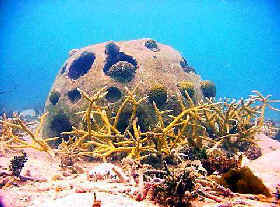
Southwest Florida Fishing News
September 2000
REEF BALL UPDATE
"REEF BALL " NEWS:
NEW TECHNOLOGY ALLOWS CORAL REVITALIZATION
WITHOUT DAMAGE TO EXISTING REEFS
By Todd Barber, President & CEO, Reef Ball Development Group, Ltd.
We're back from Pago Pago and
the Coral Reef Task Force Meetings. The overriding theme of the meeting was to meet the Presidential mandate to protect
20% of US coral reefs by the year 2010.
Thanks to our work with C.O.R.L., Seaquest, Fish and Wildlife of American Somoa, Marine
Biologists at the Community College of American Somoa, plus the pioneering work of Dr. Austin Kirby Bowden,
Coralations, G.A.R.F. and thousands of marine aquarium hobbyists, Reef Ball is now introducing Reef Ball molds in Bay Ball and larger
sizes with modifications to accept standardized asexual coral propagation plugs. Training is available from several
organizations on the creation and farming of these plugs . . . usually from second or third generation mother corals to insure no damage to natural reefs. Some organizations, such as Applied Marine Technologies, even offer pre-fanned plugs in aquacultured conditions.
Although special permits are usually required to undertake this type of work, it is simple enough for classrooms, dive clubs, local governmental staffs or others to accomplish with high degrees of success. And the technology is not expensive! In fact, with
volunteers doing the work, it is practically free!
This technology is superior to past governmental "restoration" works where coral heads were essentially transplanted whole which resulted in high mortality rates because the corals were not properly adapted to the new location in terms of lighting, currents and other conditions. Additionally, this newer method does not require
harming the existing coral heads in the wild. With asexual propagation techniques, coral reef revitalization can be sped up tremendously. However, the Reef Balls must be designed to allow additional natural settlement of new corals to make sure that species diversity of the natural reefs is ultimately achieved
Expect this work to be the standard of excellence for areas where slow-growing hard corals have discouraged the use of designed artificial reefs due to the longer time horizons required to achieve a natural balance.
Existing Reef Ball reefs can be retrofitted with this technology, but the propagation techniques are more time consuming than with the newly developed standardized plug receptacles. However, it is simple to adapt your existing Reef Ball molds to the new technology so that future Reef Balls made with your molds can accept the standardized propagation plugs.
Visit The Reef Ball website at www.reefball.com
for more interesting facts about Reef Balls
The Reef Ball Coalition website is at:
www.reefballcoalition.org